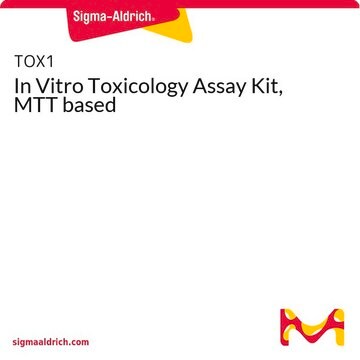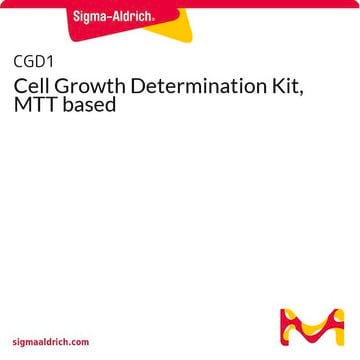The solution may be filtered through a 0.2 μm filter and stored at 2-8°C for frequent use or stored in aliquots and frozen at -20°C for extended periods.
M5655
噻唑蓝
powder, BioReagent, suitable for cell culture, suitable for insect cell culture, ≥97.5% (HPLC)
别名:
3-(4,5-二甲基-2-噻唑)-2,5-二苯基溴化四氮唑噻唑蓝, 噻唑四唑蓝溴化盐, 噻唑蓝四唑蓝
选择尺寸
$87.40
有货详情
选择尺寸
About This Item
$87.40
有货详情
推荐产品
產品線
BioReagent
品質等級
化驗
≥97.5% (HPLC)
形狀
powder
技術
cell culture | insect: suitable
cell culture | mammalian: suitable
mp
195 °C (dec.) (lit.)
溶解度
H2O: 5 mg/mL
儲存溫度
2-8°C
SMILES 字串
[Br-].Cc1nc(sc1C)-[n+]2nc(nn2-c3ccccc3)-c4ccccc4
InChI
1S/C18H16N5S.BrH/c1-13-14(2)24-18(19-13)23-21-17(15-9-5-3-6-10-15)20-22(23)16-11-7-4-8-12-16;/h3-12H,1-2H3;1H/q+1;/p-1
InChI 密鑰
AZKSAVLVSZKNRD-UHFFFAOYSA-M
正在寻找类似产品? 访问 产品对比指南
應用
訊號詞
Warning
危險分類
Eye Irrit. 2 - Muta. 2 - Skin Irrit. 2 - STOT SE 3
標靶器官
Respiratory system
儲存類別代碼
11 - Combustible Solids
水污染物質分類(WGK)
WGK 3
閃點(°F)
Not applicable
閃點(°C)
Not applicable
個人防護裝備
Eyeshields, Gloves, type N95 (US)
其他客户在看
-
Should I prepare fresh for each use or I directly resuspend in 20 ml of water (for the 100 mg bottle) and store? In the latter case, how can I store the solution?
1 answer-
Helpful?
-
-
What's the difference between M5655 and M2003?
1 answer-
Product M5655 is Thiazolyl Blue Tetrazolium Bromide and Product M2003 is Thiazolyl blue formazan.
MTT (Cat. no. M5655) is used in the measurement of cell proliferation. MTT produces a yellowish solution that is converted to dark blue, water-insoluble MTT formazan (Product M2003) by mitochondrial dehydrogenases of living cells. The blue MTT formazan crystals are solubilized with acidified isopropanol and the intensity is measured colorimetrically at 570 nm. Thus, the amount of blue formazan is proportional to the number of viable cells. For more information regarding this particular assay, we do offer an assay kit, TOX1, which is based on this principle: https://www.sigmaaldrich.com/product/sigma/tox1.
Helpful?
-
-
What type of multi-well plate should be used for the Thiazolyl Blue Tetrazolium Bromide (MTT) assay?
1 answer-
It is recommended that flat bottom multi-well plates be used for the MTT assay. The use of tissue culture treated plates is only important if necessary for good cell growth. If cells are grown in larger plates, the supernatant after cell lysis can be transferred to a 96 well plate for reading.
Helpful?
-
-
Is the MTT assay quantitative?
1 answer-
The MTT asay is a method to assess cell viability. This assay is a semiquantitative assay. The assay is used to compare the viability changes in treated cells to untreated cells. The absorbance is indicative of the cell number. The higher the absorbance, the greater the number of viable cells present. Most researchers compare the absorbance of the two samples as a ratio (ABS treated cells/ABS untreated cells) to get a fold increase/decrease in cell number.
Helpful?
-
-
How can I store solutions of Thiazolyl Blue Tetrazolium Bromide (MTT)?
1 answer-
Reconstituted MTT solution is stable for at least 6 months when stored frozen (-20 °C). Storage of reconstituted MTT solution at 2-8°C for more than 2 weeks may cause decomposition and yield erroneous results.
Helpful?
-
-
What is the Department of Transportation shipping information for this product?
1 answer-
Transportation information can be found in Section 14 of the product's (M)SDS.To access the shipping information for this material, use the link on the product detail page for the product.
Helpful?
-
-
What can be used to make a solution of Thiazolyl Blue Tetrazolium Bromide (MTT)?
1 answer-
We test the solubility of MTT in water at a concentration of 5 mg/mL. For the MTT viability assay, we dissolve Product No. M5655 at a concentration of 5 mg/ml in RPMI-1640 without phenol red. This medium is available as a powder (Product No.R8755) or liquid (Product No. R7509). MTT can be solubilized in any culture media or balanced salt solution that does not contain phenol red as a pH indicator.
Helpful?
-
-
Why is a reference wavelength used for data analysis of Thiazolyl Blue Tetrazolium Bromide (MTT)?
1 answer-
The reference wavelength (630-690 nm) is used to adjust for the optical variation in the wells of the plate. It also corrects for dust and fingerprints that can be present. The assay is read at 570 nm. The reference wavelength needs to be far enough away from the assay wavelength so as not to affect those values.
Helpful?
-
-
How can Thiazolyl Blue Tetrazolium Bromide be used for staining dehydrogenase in tissue sections?
1 answer-
Products M2128 or M5655, Thiazolyl Blue Tetrazolium Bromide can be used for staining dehydrogenase in tissue sections. See the method below. Reagent PreparationMTT (2 mg/ml distilled water) 2.5 ml0.2 M Tris buffer, pH 7.4 2.5 ml0.5 M cobalt chloride 0.5 ml0.05 M magnesium chloride 1.0 mlDistilled water 2.5 mlThe pH of this solution is adjusted to 7.0 if necessary. Aliquot and store at -20°C until required. Sample PreparationCut cytostat sections at 5 to 7 microns. Do not fix. Method:1. Incubate sections in appropriate incubation solution at 37°C for 30-60 minutes.2. Transfer sections to 15% formol saline, 15 minutes.3. Wash in distilled water4. Counterstain in 2% methyl green if required.5. Wash in distilled water.6. Mount in glycerin Jelly. ResultsEnzyme: Black formazan deposits with MTT Source: Bancroft and Gamble, Theory and Practice of Histological Techniques, Fifth Edition. Churchill Livingstone, London, 2002, page 610.
Helpful?
-
-
What can be used to solubilize MTT formazan (the product of the Thiazolyl Blue Tetrazolium Bromide - MTT reaction)?
1 answer-
Mitochondrial dehydrogenases of viable cells cleave the tetrazolium ring of the MTT, yielding purple MTT formazan crystals. These crystals are not soluble in aqueous solutions; they may be dissolved in acidified isopropanol (0.1 N HCl in anhydrous isopropanol). If this does not lyse the cells, Triton X-100 can be added to the acidified isopropanol. A typical working concentration is 10% Triton X-100 (i.e., 1 volume of 100% Triton X-100 + 9 volumes of acidified isopropanol).
Helpful?
-
Active Filters
我们的科学家团队拥有各种研究领域经验,包括生命科学、材料科学、化学合成、色谱、分析及许多其他领域.
联系技术服务部门











